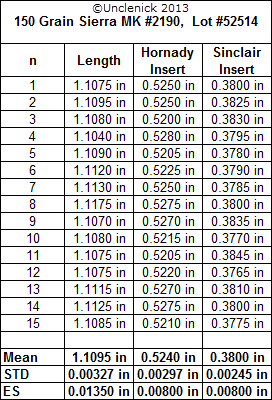You are using an out of date browser. It may not display this or other websites correctly.
You should upgrade or use an alternative browser.
You should upgrade or use an alternative browser.
COAL variations
- Thread starter Jasun
- Start date
I think the "sloppiness" in the press can have something to do with it. Progressives can have some give to them between the shellholder and the turret top that's holding the dies. We aren't talking about much, but it can be noticeable, depending on the press.
Also some seating dies don't seat from the tip but from the ogive so that the lead tip won't become distorted. Well... not all ogives will be the same. So the tip where you measure it will be different from loaded round to loaded round.
As time goes by, with lead rounds, the lube will also build up in the seating die... just an example that I've seen.
Also some seating dies don't seat from the tip but from the ogive so that the lead tip won't become distorted. Well... not all ogives will be the same. So the tip where you measure it will be different from loaded round to loaded round.
As time goes by, with lead rounds, the lube will also build up in the seating die... just an example that I've seen.
"Sloppiness" in the press and the dies. Although "sloppiness" isn't the right word. There will be a wee bit of 'give' in both.
More often that the operator doesn't cycle the ram exactly the same every time. OAL isn't the most important variable anyway. 'Fits in the mag' is used as the OAL by times.
More often that the operator doesn't cycle the ram exactly the same every time. OAL isn't the most important variable anyway. 'Fits in the mag' is used as the OAL by times.
OAL will vary about +/- .005" with any progressive. It's just differences in bullet diameter, case ID, and seating pressure. Won't make any difference at all inside 100 yards. If you are running a progressive, all stations have to be full to check correctly. And remember, case lengths can vary +/- .005" also. But the only thing that changes on a press are bullets and cases, not dies or shell plate, if properly installed. Dies and shell plates can come loose from repeated loading, over 20,000 rounds or so.,
Most seating dies meet the bullet at its ogive. Most ogives suffer irregularities in the ogive diameter due mainly to bullets off multiple sets of tooling all being mixed together in their boxes. Even Sierra match bullets vary in this area.
Below are the lengths of 15 Sierra match bullets, their length from base to ogive contact point on a Hornady comparator and the their length from base to ogive using a Sinclair comparator insert that is closer to the shape of a rifle throat. You can see there would be no way to get exact seating results. It's one reason I think people setting bullet jump in steps of five thousandths are likely fooling themselves about any apparent difference it makes in precision (group size). It takes at least 0.010" just to get past the variation in bullet contact surface location.

Below are the lengths of 15 Sierra match bullets, their length from base to ogive contact point on a Hornady comparator and the their length from base to ogive using a Sinclair comparator insert that is closer to the shape of a rifle throat. You can see there would be no way to get exact seating results. It's one reason I think people setting bullet jump in steps of five thousandths are likely fooling themselves about any apparent difference it makes in precision (group size). It takes at least 0.010" just to get past the variation in bullet contact surface location.

I use a single stage RCBS Rockchucker. With a difference in case sizing with a full length sizing die, checking cases headspace to .001 When setting up your seated die, all your seated bullets would be exact from head to ogive. if your cases have different headspace just by sizing without checking every case measurment , your OAL will have the same variations. Brass could have different thicknesses, some may expand more then stretch, I measure all fired & sized cases before seating
Not all secants are equal. Their mating surfaces do not all engage the die at the same spot so can create variances. You can separate bullets out using a comparator so they are in lots if you want to go that far. Lymans 49th states up to .005" is acceptabe but watch out for the max loads. If you drift further out, find out why then decide if you want to use them.
